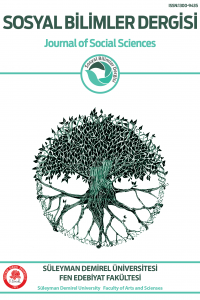Öz
Mind reading is an important aspect of narrative in
Jane Austen’s fiction. Austen presents mind reading as the most effective
element in the construction and development of her narrative plot in Persuasion.
She mainly shows how mind reading can derive from thinking biases and bring about
significant misunderstandings. By focusing on the central character Anne Elliot’s
desire to read her ex-fiancé’s mental states in different situations, Austen
explores the impact of mind reading quality and capacity on their relationship.
Offered by the narratologist Lisa Zunshine, mind reading refers to our ability
to attribute or ascribe mental states to ourselves and to other people. Relying
on Zunshine’s terminology and considering her elaboration on the three main
steps of mind reading, this paper has two main goals. Firstly, the essay analyses
the way(s) Anne Elliot’s mind reading capacity is presented in terms of body
language, performance, and embodied transparencies. Secondly, the paper
examines the reliability state of Anne’s mind readings, as well as the effect
of her cognitive distortions.
Anahtar Kelimeler
: Cognitive Narratology Mind Reading Cognitive Distortion Persuasion Jane Austen
Kaynakça
- Alexander, Michael (2000). A History of English Literature. London, MacMillan Press. Austen, Jane (2008). Emma. Oxford, Oxford University Press.__________ (2004). Persuasion. Oxford, Oxford University Press.__________ (2003). Pride and Prejudice. London, Bantam Press.Booth, Wayne C. (1983). The rhetoric of fiction. Chicago, Univ. of Chicago Press.Leavis, F. R. (2011). The Great Tradition: George Eliot, Henry James, Joseph Conrad. London, Chatto & Windus.Nayebpour, Karam (2017). “The Training Impact of Experience in Jane Austen’s Emma”, Brno Studies in English, Vol. 43, No. 2, pp. 127-149. https://digilib.phil.muni.cz/handle/11222.digilib/137611 [Access: 02.04.2018]Richardson, Alan (2002). “Of Heartache and Head Injury: Reading Minds in Persuasion”, Poetics Today, Vol. 23, No. 1, pp. 141-160. https://doi.org/10.1215/03335372-23-1-141 [Access: 22.01.2018]Smith, Karah L. (2017). “Cognitive Embodiment and Mind Reading in Jane Austen's Persuasion”, INQUIRIES Journal, Vol. 9, No. 10, pp. 1/1. http://www.inquiriesjournal.com/articles/1676/cognitive-embodiment-and-mind-reading-in-jane-austens-persuasion [Access: 12.03.2018] Watkin, Amy (2007 fall). “Why We Read Fiction: Theory of Mind and the Novel. By Lisa Zunshine”, The Journal of the Midwest Modern Language Association, Vol. 40, No. 2, pp. 141–143. https://www.jstor.org/stable/20464240?seq=1#metadata_info_tab_contents [Access: 09.04.2018]Zunshine, Lisa (2012). Getting Inside Your Head: What Cognitive Science Can Tell Us about Popular Culture. Baltimore, The Johns Hopkins University Press. https://www.jstor.org/stable/10.5325/style.45.2.349#metadata_info_tab_contents [Access: 12.03.2018] ____________ (2011 summer). “Style Brings in Mental States”, Style, Vol. 45, No. 2, pp. 349–356. ____________ (2008). “Theory of Mind and Fictions of Embodied Transparency”, Narrative Vol. 16, No. 1, pp. 65–92.____________ (2006). Why We Read Fiction: Theory of Mind and the Novel. Ohio, the Ohio State University Press.Yurica, Carrie L. and DiTomasso, Robert A. (2004). “Cognitive Distortions.” Encyclopedia ofCognitive Behavior Therapy. Ed. Arthur Freeman. New York: Springer. 117-122.
Öz
Kaynakça
- Alexander, Michael (2000). A History of English Literature. London, MacMillan Press. Austen, Jane (2008). Emma. Oxford, Oxford University Press.__________ (2004). Persuasion. Oxford, Oxford University Press.__________ (2003). Pride and Prejudice. London, Bantam Press.Booth, Wayne C. (1983). The rhetoric of fiction. Chicago, Univ. of Chicago Press.Leavis, F. R. (2011). The Great Tradition: George Eliot, Henry James, Joseph Conrad. London, Chatto & Windus.Nayebpour, Karam (2017). “The Training Impact of Experience in Jane Austen’s Emma”, Brno Studies in English, Vol. 43, No. 2, pp. 127-149. https://digilib.phil.muni.cz/handle/11222.digilib/137611 [Access: 02.04.2018]Richardson, Alan (2002). “Of Heartache and Head Injury: Reading Minds in Persuasion”, Poetics Today, Vol. 23, No. 1, pp. 141-160. https://doi.org/10.1215/03335372-23-1-141 [Access: 22.01.2018]Smith, Karah L. (2017). “Cognitive Embodiment and Mind Reading in Jane Austen's Persuasion”, INQUIRIES Journal, Vol. 9, No. 10, pp. 1/1. http://www.inquiriesjournal.com/articles/1676/cognitive-embodiment-and-mind-reading-in-jane-austens-persuasion [Access: 12.03.2018] Watkin, Amy (2007 fall). “Why We Read Fiction: Theory of Mind and the Novel. By Lisa Zunshine”, The Journal of the Midwest Modern Language Association, Vol. 40, No. 2, pp. 141–143. https://www.jstor.org/stable/20464240?seq=1#metadata_info_tab_contents [Access: 09.04.2018]Zunshine, Lisa (2012). Getting Inside Your Head: What Cognitive Science Can Tell Us about Popular Culture. Baltimore, The Johns Hopkins University Press. https://www.jstor.org/stable/10.5325/style.45.2.349#metadata_info_tab_contents [Access: 12.03.2018] ____________ (2011 summer). “Style Brings in Mental States”, Style, Vol. 45, No. 2, pp. 349–356. ____________ (2008). “Theory of Mind and Fictions of Embodied Transparency”, Narrative Vol. 16, No. 1, pp. 65–92.____________ (2006). Why We Read Fiction: Theory of Mind and the Novel. Ohio, the Ohio State University Press.Yurica, Carrie L. and DiTomasso, Robert A. (2004). “Cognitive Distortions.” Encyclopedia ofCognitive Behavior Therapy. Ed. Arthur Freeman. New York: Springer. 117-122.
Ayrıntılar
| Birincil Dil | İngilizce |
|---|---|
| Bölüm | Filoloji |
| Yazarlar | |
| Yayımlanma Tarihi | 31 Aralık 2020 |
| Yayımlandığı Sayı | Yıl 2020 Sayı: 51 |
Kaynak Göster
Süleyman Demirel Üniversitesi Fen-Edebiyat Fakültesi Sosyal Bilimler Dergisi


